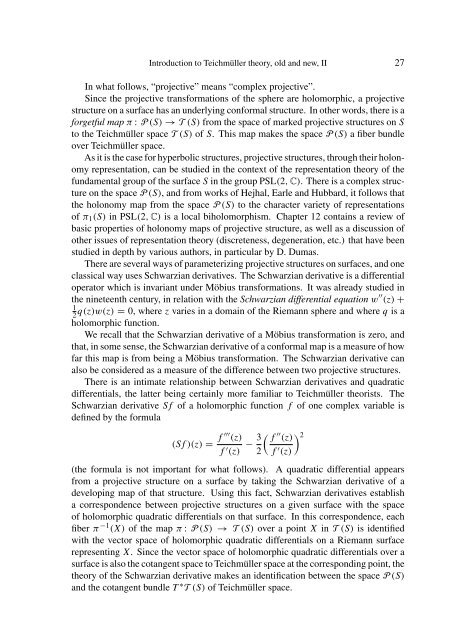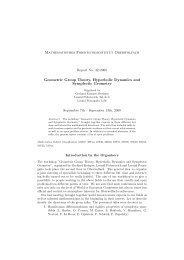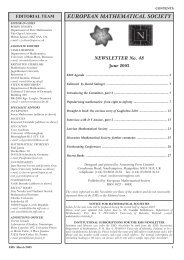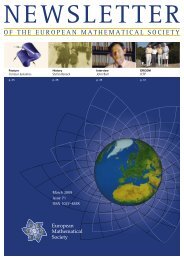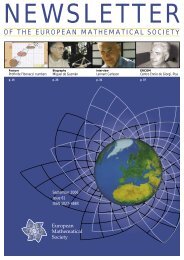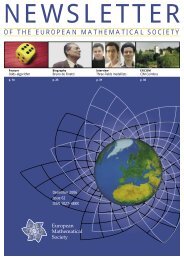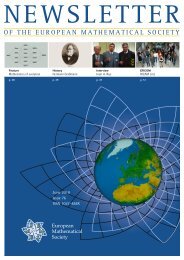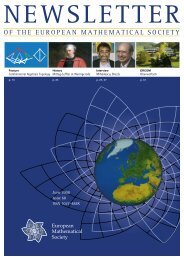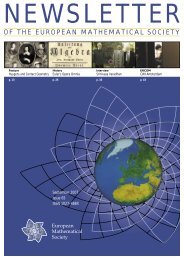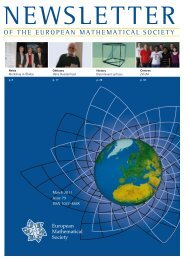Introduction to Teichmüller theory, old and new, II
Introduction to Teichmüller theory, old and new, II
Introduction to Teichmüller theory, old and new, II
Create successful ePaper yourself
Turn your PDF publications into a flip-book with our unique Google optimized e-Paper software.
<strong>Introduction</strong> <strong>to</strong> <strong>Teichmüller</strong> <strong>theory</strong>, <strong>old</strong> <strong>and</strong> <strong>new</strong>, <strong>II</strong> 27<br />
In what follows, “projective” means “complex projective”.<br />
Since the projective transformations of the sphere are holomorphic, a projective<br />
structure on a surface has an underlying conformal structure. In other words, there is a<br />
forgetful map π : P (S) → T (S) from the space of marked projective structures on S<br />
<strong>to</strong> the <strong>Teichmüller</strong> space T (S) of S. This map makes the space P (S) a fiber bundle<br />
over <strong>Teichmüller</strong> space.<br />
As it is the case for hyperbolic structures, projective structures, through their holonomy<br />
representation, can be studied in the context of the representation <strong>theory</strong> of the<br />
fundamental group of the surface S in the group PSL(2, C). There is a complex structure<br />
on the space P (S), <strong>and</strong> from works of Hejhal, Earle <strong>and</strong> Hubbard, it follows that<br />
the holonomy map from the space P (S) <strong>to</strong> the character variety of representations<br />
of π1(S) in PSL(2, C) is a local biholomorphism. Chapter 12 contains a review of<br />
basic properties of holonomy maps of projective structure, as well as a discussion of<br />
other issues of representation <strong>theory</strong> (discreteness, degeneration, etc.) that have been<br />
studied in depth by various authors, in particular by D. Dumas.<br />
There are several ways of parameterizing projective structures on surfaces, <strong>and</strong> one<br />
classical way uses Schwarzian derivatives. The Schwarzian derivative is a differential<br />
opera<strong>to</strong>r which is invariant under Möbius transformations. It was already studied in<br />
the nineteenth century, in relation with the Schwarzian differential equation w ′′ (z) +<br />
1<br />
2<br />
q(z)w(z) = 0, where z varies in a domain of the Riemann sphere <strong>and</strong> where q is a<br />
holomorphic function.<br />
We recall that the Schwarzian derivative of a Möbius transformation is zero, <strong>and</strong><br />
that, in some sense, the Schwarzian derivative of a conformal map is a measure of how<br />
far this map is from being a Möbius transformation. The Schwarzian derivative can<br />
also be considered as a measure of the difference between two projective structures.<br />
There is an intimate relationship between Schwarzian derivatives <strong>and</strong> quadratic<br />
differentials, the latter being certainly more familiar <strong>to</strong> <strong>Teichmüller</strong> theorists. The<br />
Schwarzian derivative Sf of a holomorphic function f of one complex variable is<br />
defined by the formula<br />
(Sf )(z) = f ′′′ (z)<br />
f ′ (z)<br />
<br />
3 f ′′ (z)<br />
−<br />
2 f ′ 2 (z)<br />
(the formula is not important for what follows). A quadratic differential appears<br />
from a projective structure on a surface by taking the Schwarzian derivative of a<br />
developing map of that structure. Using this fact, Schwarzian derivatives establish<br />
a correspondence between projective structures on a given surface with the space<br />
of holomorphic quadratic differentials on that surface. In this correspondence, each<br />
fiber π −1 (X) of the map π : P (S) → T (S) over a point X in T (S) is identified<br />
with the vec<strong>to</strong>r space of holomorphic quadratic differentials on a Riemann surface<br />
representing X. Since the vec<strong>to</strong>r space of holomorphic quadratic differentials over a<br />
surface is also the cotangent space <strong>to</strong> <strong>Teichmüller</strong> space at the corresponding point, the<br />
<strong>theory</strong> of the Schwarzian derivative makes an identification between the space P (S)<br />
<strong>and</strong> the cotangent bundle T ∗ T (S) of <strong>Teichmüller</strong> space.


